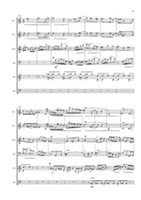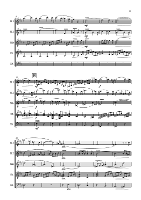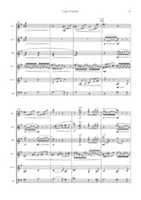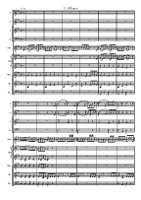Cantô

| instrumentation | plucked string orchestra (mandolin 1 and 2, mandola, mandoloncello, guitar and double bass) |
| finished | 20 July 2012 |
| dedication | Michiko Kataoka and the Ensemble Testa Calda |
| movements | – |
| duration | 17 min. |
| first performance | 23 February 2013 |
| published | Joachim-Trekel-Musikverlag |
The composition “Cantô” is a commissioned work dedicated to Michiko Kataoka and the Ensemble Testa Calda in Tokyo. The piece presents and develops mostly lyrical material in a single huge movement in sonata form.
The region Kantô in Japan consists of seven prefectures and “Cantô” can be divided in seven parts that refer each to one prefecture. “Cantô” is thus a wordplay of “canto” (Italian “chant”) and “Kantô” (Japanese region around Tokyo).
The introduction is called SAITAMA. Its musical themes depict the green hilly landscapes of the national park with the climax being the highest rise of the area.
The exposition consists of two parts, the first section named GUNMA is a barren theme over static tremolo, only accompanied by a few small guitar motives. The second section CHIBA refers with its high tempo, ostinatos and nervous melody segments to areas like the airport, Disneyland and also reminds of the severe earthquake from 2011.
The development is named IBARAKI, as the region was famous for its many mines and martial habitants in the past. The section begins slowly, then a big fugue accounts for the majority of this part. It develops most of the material and reaches its climax at the return of the main theme, here entitled TÔKYÔ. This is the climax of the whole piece, and therefore it is named after the most important prefecture of Kantô.
The recapitulation combines both themes in a new way, and the section is called TOCHIGI referring with its national park to the one in Saitama.
A long coda named KANAGAWA ends the piece, depicting with softly flowing material the landscapes of that area.
Capriccio
| instrumentation | plucked string orchestra (mandolin 1 and 2, mandola, guitar and double bass) |
| finished | 27 August 2002 |
| dedication | Landesjugendzupforchester Brandenburg/Berlin (LJZO) |
| movements | – |
| duration | 6 min. |
| first performance | 26 October 2003 in the Auenkirche Berlin-Wilmersdorf by the LJZO |
| published at | Vogt & Fritz |
The Capriccio is a concert piece in ABA form with a slow introduction. The opening adagio contains already some elements, that become important in the main section: the circling around E, chords of fourths and fifths, the rhythm “short-long-short”, the tritones as an important accompanying interval. In the following vivo most of the action takes place in front of a rhythmical ostinato. The middle section (moderato, “groovy”) presents a theme in the mandola, which is continued by the second mandoline. The material is developed canonically and appears in parallels with changed rhythm. A little percussion is added and then a final phrase in the base register prepares the recapitulation of the main part. The coda uses the material of the middle section, joints it with the ostinato of the main part and produces a triumphal ending of the piece.
Concerto da Camera
| instrumentation | plucked string ensemble or orchestra (mandoline 1 and 2, mandola, guitar and double bass) |
| finished | 1 November 2006 |
| dedication | Spielkreis für Zupfinstrumente Berlin |
| movements | 1. Allegro fluente – 2. Andante molto sostenuto e cantabile – 3. Allegro assai |
| duration | 10 min. |
| first performance | 20 November 2010 in the Fontanehaus Berlin by the Teg’ler Zupforchester Berlin (TZO) |
| published at | Joachim-Trekel-Musikverlag |
The “Concerto da Camera” originated from a suggestion of the “Spielkreis für Zupfinstrumente” (which is a part of the Teg’ler Zupforchester and situated in Berlin).
It is a composition in three movements referring to baroque and classical models. The aim was to create a piece that is easily playable while providing appealing musical structures, to satisfy aesthetic as well as artistic demands.
The first movement is in three parts and begins with a happy theme, moving from C major to G major. After a short break the contrasting middle part appears in B major. A lyrical melody is presented and varied, before the main part returns. A short coda concludes this friendly head movement.
The second movement mainly consists of broken chords demanding a particularly calm interpretation. The motion moves from the first mandoline to the mandola and back. Then the middle section follows in a resolute manner. Its sharp dotted notes appear very strict and form a big contrast to the floating motions of the main part. Those two characteristics come together when the main section returns. At the end the broken chords from the beginning remain in finest pianissimo.
The third movement is a larking finale: An energetic theme is presented, suddenly terminated in the repetition and developped in fugal style. The tumultuous polyphony leads finally back to the middle section of the beginning theme and prepares a short ending sequence which rounds up the piece harmoniously.
Concerto No. 1

| instrumentation | plucked string orchestra (mandolin 1 and 2, mandola, guitar and double bass) |
| finished | February 1998 (revised version, first version finished 1995) |
| dedication | Heinz Pfalzgraf (posthumously) |
| movements | 1. Allegro – 2. Andante con moto – 3. Allegro giocoso |
| duration | 11 min. |
| first performance | 5 December 1998 in the Fontanehaus in Berlin-Reinickendorf by the Teg’ler Zupforchester |
| published | – |
The style of this Concerto is romantic to folkloristic, but it makes use of classical forms. The opening allegro is a sonata movement with two themes. The sequence of diminished chords at the beginning reoccurs before the recapitulation and the coda.
The second movement gives a romantic impression by its diffuse harmonics. In the middle section it is the guitars that present a happy melody in D major.
In the third movement a spirited theme appears after a slow introduction. The contrasting middle section uses material of the second movement.
Concerto Nr. 2

| instrumentation | solo violin and plucked string orchestra (mandolin 1 and 2, mandola, guitar and double bass) |
| finished | 21 December 1997 |
| dedication | – |
| movements | 1. Allegro moderato – 2. Andante sostenuto – 3. Molto vivo e ritmico |
| duration | approx. 18 min. |
| first performance | 19 June 2004 in the concert hall of the University of Arts Berlin by the Landeszupforchester Berlin (LZO) |
| published at | – |
The Concerto Nr. 2 is the first step into harmonic areas beyond tonality. It begins with a sonata movement that presents traditionally two themes. These are developed thoroughly, resulting in various characteristics.
In the second movement different counter parts are added in ten variations to a contemplative theme, that occurs like in a passacaglia.
The final follows attacca after the slow movement. Several small motives show up tumultuously, before the grotesque dance in the middle section reminds of Shostakovich. After a big cadenza, where all themes of the concert return, the recapitulation follows. Heavy action in all parts, then a reminiscence to the opening movement and finally a stretto spiritedly ending the concerto.
Concero Nr. 3

| instrumentation | solo mandolin, percussion and plucked string orchestra (mandolin 1 and 2, mandola, guitar and double bass) |
| finished | 26 January 2009 |
| dedication | Berliner Zupforchester (BeZO) |
| movements | 1. Allegro – 2. Largo – 3. Grave. Allegretto |
| duration | ca. 17 min. |
| first performance | 3 May 2009 in the small hall of the Berlin Philharmony by the Berliner Zupforchester |
| published at | Joachim-Trekel-Musikverlag |
The Concerto Nr. 3 walks on the paths of Dmitri Shostakovich. Especially the symphonies and solo concertos of the Russian composer served as models.
The first movement is a classical sonata movement. After a beat of the base drum the solo instrument begins the main theme with hardly any acompaniment. The following motives are manifold, after a dramatic development and a long cadenza the recapitulation appears in the manner of a march.
The contemplative atmosphere of the second movement makes it the emotional climax of the concerto. Two themes alternate resulting in a five-part form.
The third movement is a spirited final that works once more with material heared in the first movement. Here the solo mandolin can prove its virtuosity.
Concerto Nr. 4

| instrumentation | solo clarinet and plucked string orchestra (mandolin 1 and 2, mandola, guitar and double bass) |
| finished | 10 December 2013 |
| dedication | Teg’ler Zupforchester (TZO) |
| movements | 1. Allegro – 2. Vivace – 3. Andante – 4. Allegro giocoso |
| duration | ca. 14 min. |
| first performance | 22 November 2014 in Berlin by the Teg’ler Zupforchester |
| published at | Joachim-Trekel-Musikverlag |
Concerto Nr 4, written for the Teg’ler Zupforchester, is the last work of the series, and it adds two facets to the cycle: a fourth movement and a wind instrument, being the A-clarinet, as a solo.
The first movement opens with a tutti forte, and introduces immediately the main theme in lydian D. The music moves freely through the circle of fifths, while appearing always tonal and fresh. The motives of the main theme are extensively developed and combined with new material. After a small climax and a transition to the middle part a lyrical theme follows which much tremolo in the orchestra. It is developed as well and returns in expanded form with an almost hymn-like character. After a short cadenza the main theme reappears with the middle part cantilene added. The movement ends quietly in the deep registers of the orchestra.
The second movement is a spooky scherzo. The theme and accompaniment are highly chromatic, the Music rarely goes beyond piano. The trio sounds klezmer-like, it uses the so-called gypsy scale in the solo part, while the orchestra accompanies with colorful chromatic chords. Upon return the scherzo is extended by a coda and disappears finally into chromatic pianissimo.
The third, slow movement in free form features romantic melodies, primarily in the solo part, and a continuous “walking bass”, giving the double bass a special and important role. The climaxes in bars 34 and 47 are based on the principle of the golden ratio.
In the last movement humorous enthusiasm reenters the focus of attention. A funny melody is exposed, which drifts off to harmonically indeterminate, sometimes even wrong-sounding sub-themes. Sudden unisons mark transitions to new sections. After tender reminiscences of some motives, separated by general rests, a surprisingly famous quote announces the return of the main theme. The music ends in boisterous cheering with syncopes, colorful chords and trill-heavy antics in the solo instrument.
Crags of Ayrshire

| instrumentation | plucked string orchestra (mandolin 1 and 2, mandola, guitar 1 and 2, double bass) with percussion ad lib. |
| finished | 18 March 2018 |
| dedication | Landesjugendzupforchester Brandenburg/Berlin (LJZO) |
| movements | – |
| duration | ca. 16 min. |
| first performance | 11 May 2024 during the “Festival der Landesorchester”, Wirges |
| published at | – |
“Crags of Ayrshire” is based on a journey of the LJZO Brandenburg/Berlin to Scotland in autumn 2016. The programmatic concert piece in sonata form draws a portrait of the romantic “Culzean Castle” at the bay of South Ayrshire in western Scotland.
The introduction describes the morning mood at the cliffs of Ayrshire: wafts of mist rise while a light breeze crosses Country Park, depicted by altered chords in up to six voices of tremolo.
In the exposition of the main part the castle becomes visible in the morning haze. The main theme of the work shows phrases of strictly 4 bars each to represent the regular geometry of the castle’s architecture. The mist vanishes, while the theme raises to a noble fortissimo ending with a tutti climax in B flat.
A keen cut to C sharp minor marks the beginning of the secondary theme in 6/8, portraying the unsteady weather at the bay: wind, drizzle, waves at the rough sea, dramatic cloud formations… The theme (or rather the motif shreds) is laid out accordingly in irregular bits. The instruments constantly interrupt each other in different phrase lengths and individual dynamics and thus build up for the next climax to the final section in G major.
After calming down the music begins the development in shimmering bitonality. A little while is spent in soft tranquility before a fugue on the main theme starts. A first climax marks the return to 6/8 metre. From here on the picture of a sea storm is drawn with lots of chromatics, sequences, tremolo and figures in semiquavers. It is a passionate section with a highly dramatic climax leading to the return of the main theme in bright forte.
The recapitulation is constructed similar to the exposition, yet shortened. The secondary theme is in E minor here and the final section in B flat.
A quiet coda follows and brings to mind some of the main motifs, before everything sinks back into fog and haziness.
Divertimento

| instrumentation | plucked string orchestra (mandolin 1 and 2, mandola, guitar, double bass) with timpani obligato |
| finished | 6 April 2015 |
| dedication | Norddeutsches Zupforchester |
| movements | 1. Invention: Allegro ritmico – 2. Klage: Andante grave e mesto – 3. Toccata: Allegro vivo |
| duration | ca. 13 min. |
| first performance | 26 February 2017 Norddeutsches Zupforchester e. V. under Maren Trekel, Peter Greszek, Hamburg |
| published at | Joachim-Trekel-Musikverlag |
The “Divertimento” for plucked string orchestra with timpani obligato was written upon a suggestion of Maren Trekel for the Norddeutsches Zupforchester and is dedicated to the ensemble.
The first movement “Invention” starts with a distinctive motive of thirds which develops into a polyphonic texture. The timpani’s entrance, a rhythmically focused theme, is continued by the orchestra. A sudden tempo change marks the second part, presenting new material. Later this is combined with the theme of the first part. A third section returns to the original tempo. The guitars accompany a tremolo cantilena, there are clear periods for the first time in the movement and the harmony is more traditional as well. Finally all three parts are developed together. An excited stretta follows, and a motive of the second section tumbles accelerando through the whole orchestra into the low register to end the movement.
The second movement “Klage” (sorrow) is a dirge to commemorate a good friend who suddenly died in October 2014. After a short introduction over static seconds of the guitar a chromatic theme is presented. It is repeated several times and condensed with the timpani only marking the next theme entry. On the climax with six-part tremolo the music suddenly stops, and after a breathless quarter rest the timpani break the silence with heavy beats. The theme returns painfully and desperately collapsing. The movement ends with empty seconds of the guitar.
In the third movement “Toccata” the main section is shaped as a fugue, while the middle section takes up again the cantilena from the first movement. Several increases direct to the final coda introduced by a long pedal tone on the dominant D and leading to a spirited ending of the piece.
Kaleidoskop
| instrumentation | plucked string orchestra (mandolin 1 and 2, mandola, guitar 1 and 2, double bass) |
| finished | 16 July 2013 |
| dedication | Landesjugendzupforchester Sachsen |
| movements | – |
| duration | 12:30 min. |
| first performance | 29 May 2014 at the Eurofestival in Bruchsal by the LJZO Sachsen |
| published at | Joachim-Trekel-Musikverlag |
KALEIDOSKOP was commissioned for the Eurofestival 2014 in Bruchsal. It is dedicated to the Landesjugendzupforchester Sachsen which played the first performance during the festival.
KALEIDOSKOP is a cycle of variations on an original theme. The individual variations together constitute a sonata form. The musical language is almost impressionistic with pentatonics, parallel voices leading in fifths and thirds, as well as chromaticism and wole tone scales.
After a brief introduction the theme is presented in the mandola. It consists of a rhapsodic canto, with changes of time which mask any clear metre. Variations I and II make up the exposition of the first and second subjects, whereas Variation III can be interpreted as the codetta of the sonata form.
After a clear break the development begins in Variation IV, where both subjects intertwine. The central Variation V is physically in the dominant, but is however only distantly related to the first subject. The rhapsodic Variation VI offers a stark contrast to it.
The reprise of the second subject is heard in Variation VII, and Variation VIII makes up the recapitulation. Variation IX represents an extended coda and reintroduces briefly and with great heightening of tension the various elements of the piece and both subjects, before KALEIDOSKOP concludes impressively with a powerful 16 bar fortissimo block.
menhir

| instrumentation | symphony orchestra (2, 2, 2, 2 – 4, 2, 3, 0, timp, str) |
| finished | 29 Sep 2020 |
| dedication | Studentenphilharmonie Tübingen |
| movements | – |
| duration | ca. 7 min. |
| first performance | 20 January 2022 in the Paul Gerhardt Church in Stuttgart by the Studentenphilharmonie Tübingen/Symeon Ioannidis |
| published at | – |
Salzburger Konzert

| instrumentation | solo mandola, recorder quartet and plucked string orchestra (mandoline 1 and 2, mandola, guitar and double bass) |
| finished | 27 May 2004 |
| dedication | – |
| movements | 1. Allegro non troppo – 2. Andante sostenuto – 3. Allegro |
| duration | ca. 18 min. |
| first performance | 28 May 2005 with the Teg’ler Zupforchester, soloist: Takaaki Shibata |
| published at | – |
The “Salzburger Konzert” is an homage to Mozart and thus remains in the style of the Viennes classic.
The head movement is like classical models a sonata movement with a double exposition. The mandola solo first appears in its repetition. A dialogue of the soloist and the orchestra develops. Near the end of the movement the soloist has the opportunity to prove his abilities in a cadence.
In the slow movement several melancholic and wollowing melodies alternate. Soloist and orchestra accompany each other here as well.
The third movement is a vital rondo. Two contrasting thoughts are opposed to the main theme and joined, as they reappear. After quaver triplets have been shown in the 2/2-beat the concert reaches a spirited ending.
Rituel
| instrumentation | plucked string orchestra (mandolin 1 and 2, mandola, guitar 1 and 2, double bass) |
| finished | 27 June 2010 |
| dedication | Landesjugendzupforchester Brandenburg/Berlin (LJZO) |
| movements | – |
| duration | 6:40 min. |
| first performance | 5 June 2011 in the church of Müncheberg by the Landesjugendzupforchester Brandenburg/Berlin (LJZO) |
| published at | Joachim-Trekel-Musikverlag |
“Rituel” was written for the LJZO Brandenburg/Berlin and its conductor Christian Laier who suggested a new piece for the orchestra. It is inspirited by the rhytmical structures in Yasuo Kuwahara’s works and in those of Stravinsky’s “Sacred du Printemps”.
A nervous introduction opens the piece, establishing the tonal language of the following ritual. The elements presented (chromatism, interfering structures, harsh dynamic contrasts, sudden unisoni) will significantly model the musical process.
The main part starts a dance with apparently irregular rhythms piling up in the orchestra. The mandola presents a theme which is extended canonically after a motoric climax. Dissonant ostinati end the main part, contrasting greatly with the contemplative middle section.
A tremolo chant by the solo mandolin represents the adoration resp. consecration within the ritual. At the end of this section a small quote from the “Sacre” refers to Stravinsky, then a frantic unisono run leads back to the dance.
After a shortened recapitulation of the main part some elements of the introduction reappear in the coda. Another climax featuring rhytmic ostinati, this time not glaring but grimly in the low registers, then the piece comes – after a short reminiscence of the solo mandoline – to a forceful finish.
“Rituel” has received the 1st prize at the composition competition “José Fernández Rojas 2010”.
